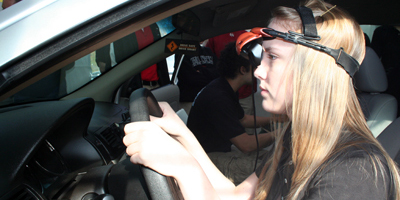
 COLUMBIA—Students at Cardinal Newman School received a driving lesson of a different kind on March 31.
COLUMBIA—Students at Cardinal Newman School received a driving lesson of a different kind on March 31.
Through the use of AWARE III, a high-tech computer simulator, they had a first-hand look at the dangers of driving under the influence.
Representatives from Professionals Encouraging Educational Reform Statewide were on campus that day so high school students could try out the simulator, which shows the drastic difference in response times and driving skills that can occur after just a few alcoholic drinks.
P.E.E.R.S. is a Michigan-based organization, www.peerawareness.com, that strives to help young people make positive lifestyle choices.
Crew leader Robert Tower and worker Zebb Dewes-Taylor are in the middle of a six-week tour of 35 schools and colleges around the country.
Tower said this is one of the program’s busiest seasons, because prom night, spring break, graduation and summer vacation offer teens many temptations to party.
Tower, who graduated from a Catholic high school in Missouri, said he has been with P.E.E.R.S. for 12 years. He worked as a bartender until a close friend was killed trying to cross a street while intoxicated.
That experience made him want to help young people learn about the dangers of drinking too much and getting behind the wheel, he said.
“I could have used these lessons in high school,” he said. “You can tell the students who really are touched by this experience. It’s especially effective if they’ve lost a relative or a personal friend to a drunk driver.”
The AWARE III simulator was hooked up to a rented Chevrolet Cobalt which was secured to the ground and set up under a tent behind a building on campus.
During the simulation, the driver wears a pair of virtual reality goggles connected to the AWARE computer. They try to maneuver the car along a course projected onto a screen inside the goggles. Many different courses are used, featuring both rural and city landscapes under a variety of weather conditions.
The programmer adjusts the computer program so the driver experiences what it would be like to maneuver the car with a blood alcohol level equal to intoxication, and then what it is like to drive the course sober.
The program can be adjusted for the subject’s height and weight.
“This lets the driver see the influence of alcohol on driving skills at different stages of intoxication,” Tower said. “They experience all the problems like tunnel vision, impaired peripheral vision, impaired judgment and coordination.”
If a driver veers off the course or hits an obstacle during the simulation, cracks show on the virtual windshield.
After the session, the driver can see all the errors they made.
As each youth took a turn, other students could watch their progress on a separate computer monitor. They laughed, gasped and shook their heads when they saw the drastic mistakes the drivers made.
“It was a lot harder than I thought it was going to be,” said senior Courtney Alexander, 17. “I overcorrected once at the beginning, took one bad turn and it was all downhill from there. It was a lot easier to control the wheel during the sober session. I was surprised how dramatic the difference was.”
Tommy Winterstein, 17, a junior, concentrated hard as he peered into the goggles and attempted to maneuver along a winding course. He reacted with a frustrated grin when he ran off the road.
“You try to go straight, but it’s tough to go straight, and then once you try to correct it you overcorrect and all of a sudden the car’s on the wrong side of the road,” he said. “In a minute everything is out of whack!”
Winterstein said the experience gave him a simple lesson about driving under the influence.
“Don’t do it,” he said. “This shows you might think it’s going to be easy, but it isn’t. This is a good lesson for young drivers.”
